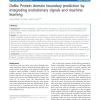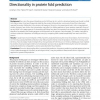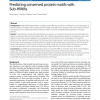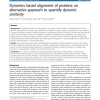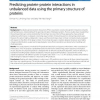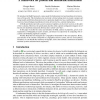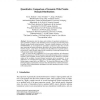BMCBI
2011
13 years 4 months ago
2011
Background: Since its inception, proteomics has essentially operated in a discovery mode with the goal of identifying and quantifying the maximal number of proteins in a sample. I...
BMCBI
2011
13 years 4 months ago
2011
Background: Accurate identification of protein domain boundaries is useful for protein structure determination and prediction. However, predicting protein domain boundaries from a...
BMCBI
2010
13 years 4 months ago
2010
Background: Ever since the ground-breaking work of Anfinsen et al. in which a denatured protein was found to refold to its native state, it has been frequently stated by the prote...
BMCBI
2010
13 years 4 months ago
2010
Background: Profile HMMs (hidden Markov models) provide effective methods for modeling the conserved regions of protein families. A limitation of the resulting domain models is th...
BMCBI
2010
13 years 4 months ago
2010
Background: The dynamic motions of many proteins are central to their function. It therefore follows that the dynamic requirements of a protein are evolutionary constrained. In or...
BMCBI
2010
13 years 4 months ago
2010
Background: Elucidating protein-protein interactions (PPIs) is essential to constructing protein interaction networks and facilitating our understanding of the general principles ...
CORR
2009
Springer
13 years 7 months ago
2009
Springer
dels at different abstraction levels; in particular, higher-level (e.g. membrane) activities can be given a formal biological justification in terms of low-level (i.e., protein) in...
PRIB
2010
Springer
13 years 7 months ago
2010
Springer
Abstract. An important unsolved problem in structural bioinformatics is that of protein structure prediction (PSP), the reconstruction of a biologically plausible three-dimensional...
ISBRA
2010
Springer
13 years 7 months ago
2010
Springer
The study of non-sequential alignments, with different connectivity of the aligned fragments in the proteins being compared can offer a more complete picture of the structural, evo...
GCB
2010
Springer
13 years 7 months ago
2010
Springer
Abstract: Investigations into the origins and evolution of regulatory mechanisms require quantitative estimates of the abundance and co-occurrence of functional protein domains amo...

